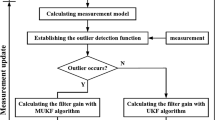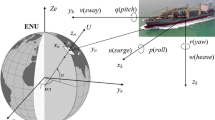Abstract
Information on trajectory and attitude is essential for analyzing gravimetric data collected on kinematic platforms. Usually, a Kalman filter is used to obtain high-accuracy positional and velocity information. However, this can be affected by measurement outliers and by state disturbances that occur frequently under a fast-changing environment. To overcome these problems, a robust adaptive Kalman filtering algorithm is applied for state estimates, which introduces an equivalent weight to resist measurement outliers and an optimal adaptive factor to balance the contributions of the kinematic model information and the measurements. In addition to the conventional robust estimator, an improved Current Statistical (CS) model is proposed. The improved CS model adopts a variance adaptive learning algorithm, and it can perform self-adaptation of acceleration variance with the innovation information; thus, it can overcome the shortcoming of lower tracking accuracy and avoid setting the maximum acceleration. Following a gravimetry campaign on the Baltic Sea, it is shown in theory and in practice that the robust adaptive Kalman filter is not only simple in its calculation but also more reliable in controlling the colored observation noise and kinematic state disturbance compared with the classical Kalman filter. The improved CS model performs best, especially when analyzing the positioning errors at the turns due to the target maneuvering. Compared to the CS model, the RMS values of the positional estimates derived from the improved CS model decrease by almost 30% in the horizontal direction, and no significant improvement in the vertical direction is found.









Similar content being viewed by others
References
Ashtech (1994) Precise differential GPS navigation and surveying (PNAV) software user’s guide, 2nd edn. Ashtech Inc., Sunnyvale
Christian K, Guenter WH (2003) GNSS based kinematic acceleration determination for airborne vector gravimetry—methods and results. ION GPS/GNSS 2003. Institute of Navigation, Portland, pp 2679–2691
Dagoberto S, Manual HP, Jose MJZ, Jaume SS, Angela AA (2011) EVA:GPS-based extended velocity and acceleration determination. J Geodesy 85(6):329–340
Gerardo AA, Oliver M (2016) Robust and precise baseline determination of distributed spacecraft in LEO. Adv Space Res 57(1):46–63
Hatch R (1982) The Synergism of GPS Code and Carrier Measurements. Proceedings of the Third International Symposium on Satellite Doppler Positioning at Physical Sciences Laboratory of New Mexico State University, Vol. 2, pp 1213–1231
He K, Xu G, Xu T, Flechtner F (2016a) GNSS navigation and positioning for the GEOHALO experiment in Italy. GPS Solut 20(2):215–224
He K, Xu T, Förste C, Petrovic S, Barthelmes F, Jiang N, Flechtner F (2016b) GNSS precise kinematic positioning for multiple kinematic stations based on a priori distance constraints. Sensors 16(470):1–11
Hong CK, Park CH, Han JH, Kwon JH (2015) Medium to long range kinematic GPS positioning with position–velocity–acceleration model using multiple reference stations. Sensors 15:16895–16909
Jekeli C, Garcia R (1997) GPS phase accelerations for moving-base vector gravimetry. J Geodesy 71(10):630–639
Kalman RE (1960) A new approach to linear filtering and prediction problems. J Fluids Eng 82(1):35–45
Kennedy S (2002b) Precise acceleration determination from carrier phase measurements. ION GPS 2002, Institute of Navigation, Portland, 962–972
Mohamed AH, Schwarz KP (1999) Adaptive Kalman filtering for INS/GPS. J Geodesy 73(4):193–203
Moose RL, Vanlangingham HF, McCabe DH (1979) Modeling and estimation for tracking maneuvering targets. IEEE Trans Aerosp Electron Syst 15(3):448–456
Rui T (2014) Fast determination of displacement by PPP velocity estimation. Geophys J Int 196(3):1397–1401
Sage AP, Husa GW (1969) Adaptive filtering with unknown prior statistics. Jt Am Control Conf 1969:769–774
Schwarz KP, Cannon ME, Wong RVC (1989) A comparison of GPS kinematic models for the determination of position and velocity along a trajectory. Manuscripta Geodaetica 14(2):345–353
Singer RA (1970) Estimating optimal tracking filter performance for manned maneuvering targets. IEEE Trans Aerosp Electron Syst 6(4):473–483
Svetozar P, Franz B, Hartmut P (2015) Airborne and shipborne gravimetry at GFZ with emphasis on the GEOHALO project, IAG 150. International Association of Geodesy Symposia, Years, pp 313–322
Teunissen PJG (1990) Quality control in integrated navigation systems. IEEE Aerosp Electron Syst Mag 5(7):35–41
Wang Q, Xu T, Xu G (2011) A method combining gross errors detection and robust estimation and its application in kinematic relative positioning. J Wuhan Univ 36(4):476–480
Xu T, He K, Xu G (2012) Orbit determination and thrust force modeling for a maneuvered GEO satellite using two-way adaptive Kalman filtering. Sci China Phys Mech Astron 55(4):738–743
Yang Y, Gao WG (2006) An optimal adaptive Kalman filter. J Geodesy 80(4):177–183
Yang Y, Xu T (2003) An adaptive Kalman filter based on Sage windowing weights and variance components. J Navig 56(2):231–240
Yang Y, He H, Xu G (2001) Adaptively robust filtering for kinematic geodetic positioning. J Geodesy 75(2):109–116
Yang Y, Song L, Xu T (2002) Robust estimator for correlated observations based on bifactor equivalent weights. J Geodesy 76(6–7):353–358
Yang Y, Ren X, Xu Y (2013) Main progress of adaptively robust filter with applications in navigation. J Navig Position 1(1):9–15
Zhang J, Zhang KF (2005) Real-time Doppler and Doppler rate derivation for dynamic applications. J Glob Position Syst 4(l):95–105
Zhou HR, Kumar KSP (1984) A “current” statistical model and adaptive algorithm for estimating maneuvering targets. AIAA J Guid 7(5):596–602
Acknowledgements
I would like to thank my GFZ colleagues for their kind help, cooperation, and discussion, and thank the EU project FAMOS: Deneb_2015 for providing the data. This study is supported by the Chinese Scholarship Council, Technical University of Berlin, German Research Centre for Geosciences Potsdam. This work is partly funded by China Key R&D Program (No. 2016YFB0501701), the National Natural Science Foundation of China (41574013, 41604027, and 41731069). We thank James Buxton, M.Sc., from Liwen Bianji, Edanz Group China (http://www.liwenbianji.cn/ac), for editing the English text of this manuscript.
Author information
Authors and Affiliations
Corresponding author
Rights and permissions
About this article
Cite this article
Li, M., He, K., Xu, T. et al. Robust adaptive filter for shipborne kinematic positioning and velocity determination during the Baltic Sea experiment. GPS Solut 22, 81 (2018). https://doi.org/10.1007/s10291-018-0747-5
Received:
Accepted:
Published:
DOI: https://doi.org/10.1007/s10291-018-0747-5




